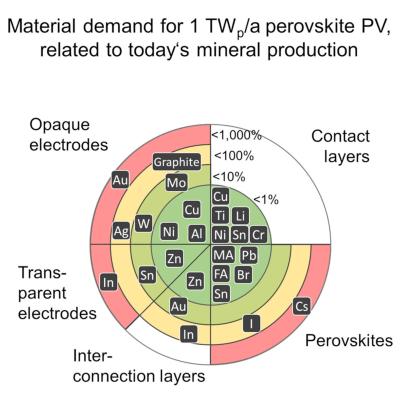Researchers from Germany's Philipps-University Marburg, Fraunhofer Institute for Solar Energy Systems ISE, Fraunhofer Research Institution for Materials Recycling and Resource Strategies IWKS, Potsdam Institute for Climate Impact Research and Sweden's Uppsala University have examined the question of availability of enough materials to produce perovskite PVs on the multi-terawatt-scale needed to make a significant contribution to climate change mitigation.
The scientists assessed the material demand for a multi-TW-scale perovskite PV production, identified potential supply risks for each material, and derived guidelines for further device optimization and material research. The study is based on a model for future multi-TW perovskite PV production that is coupled to an inventory of the most relevant materials used for PSC production. The team considered two factors of supply criticality, namely, mining capacity for minerals and the production capacity for synthetic materials.
The team found that most materials currently used in perovskite research are likely not linked to a supply risk, although replacements for some commonly used materials need to be found. In agreement with previous studies, the researchers identified an urgent need to replace the commonly used metal indium which is employed in transparent electrodes. Moreover, contrasting to previous publications, cesium used in many perovskite alloys is associated with high supply risks. Production of halides and the most promising organic solvents to coat perovskite layers require moderate scale-up. With the exception of PEDOT:PSS, the currently used organic hole-transport materials (HTMs) will only be expedient for multi-TW-scale perovskite PV production if the current material synthesis can be scaled by a factor of more than 10,000 times. The scientists found that for most organic HTLs, it is vital that synthesis routes that allow industrial upscaling be demonstrated.
This study demonstrates that, besides the improvement of efficiency and stability, perovskite PV research and development also need to be guided by sustainable materials choices and design-for-recycling considerations.


